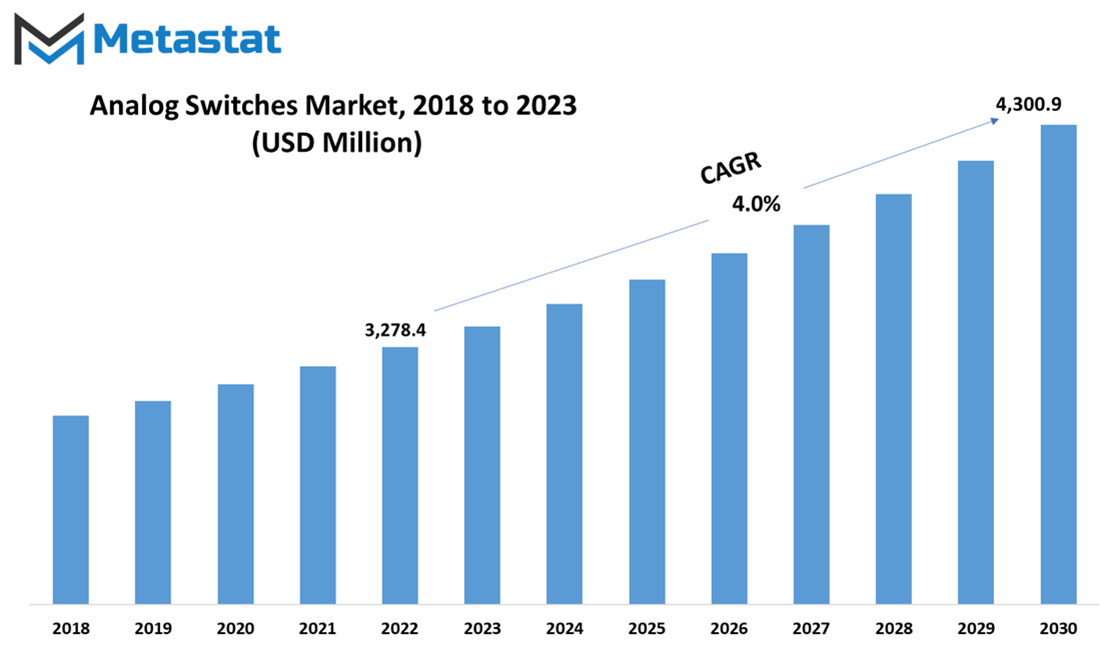MARKET OVERVIEW
The Analog Switches Market has witnessed significant technological advancements as semiconductor technology continues to progress making the analog swtiches more compact, energy-efficient, and versatile. They feature low on-resistance, minimizing signal distortion, and are capable of operating over a wide voltage range. Furthermore, innovations in packaging technologies have led to smaller and more robust analog switch devices, making them ideal for portable and high-density applications.
Analog switches, often overshadowed by their digital counterparts, play a pivotal role in various applications, from audio and video signal routing to sensor interfacing. These switches operate by allowing or blocking the flow of electrical signals, thereby enabling the control and manipulation of analog data. Their importance in the electronics realm cannot be overstated, as they form the bridge between the analog and digital worlds, ensuring that real-world signals are accurately processed and interfaced with electronic systems.
One of the remarkable features of analog switches is their low power consumption, which aligns perfectly with the growing emphasis on energy efficiency in modern electronics. As industries strive to reduce their environmental footprint and power consumption, the use of analog switches becomes even more relevant, as they enable efficient signal routing without adding a significant burden to power budgets.
In conclusion, analog switches are a cornerstone of modern electronic systems, providing the means to control and manipulate signals with precision and efficiency. Their low on-resistance, high off-isolation, and low power consumption make them indispensable in various sectors, including audio and video signal routing, instrumentation, and industrial automation. As technology continues to evolve, analog switches will remain a pivotal component, enabling the seamless flow of information and contributing to the advancement of various industries.
Global Analog Switches market is estimated to reach $4,300.9 Million by 2030; growing at a CAGR of 4.0% from 2023 to 2030.

GROWTH FACTORS
The Analog Switches Market is witnessing significant growth, driven by various factors that shape its landscape. One of the primary drivers is the increasing demand for energy-efficient and low-power-consumption electronic devices. As the world becomes more conscious of energy conservation and sustainability, the market for analog switches, which play a crucial role in minimizing power consumption, has expanded. Moreover, the growing adoption of analog switches in automotive applications, particularly in advanced driver assistance systems (ADAS), has further fueled the market's growth. ADAS relies on intricate electronic systems that require efficient signal routing and data transmission, making analog switches a vital component.
Despite these growth factors, the Analog Switches Market faces some challenges. One notable hurdle is the high competition from alternative technologies, such as digital switches. Digital switches have their advantages, and the competition between analog and digital solutions can be fierce. This competition drives innovation but can also present challenges for analog switch manufacturers.
Another challenge is the high design complexity associated with analog switches. These components must meet strict requirements for performance and reliability, which often requires sophisticated design and manufacturing processes. This complexity can lead to increased development and manufacturing costs, impacting on the market's overall competitiveness.
However, the market is not without opportunities. The rising demand for smart home devices and applications related to the Internet of Things (IoT) presents a promising avenue for analog switches. These applications often require high-speed data transmission and efficient signal routing, precisely the strengths of analog switches. As the IoT ecosystem continues to grow and diversify, the market for analog switches is poised to benefit.
In summary, the Analog Switches Market is shaped by a delicate interplay of driving factors, challenges, and opportunities. The increasing need for energy-efficient electronic devices and their adoption in automotive systems like ADAS are pivotal in driving market growth. However, competition from digital technologies and the complexity of analog switch design pose challenges. On the flip side, the growing demand for smart home and IoT applications offers a promising future for the market, where the efficiency and reliability of analog switches are highly valued.
MARKET SEGMENTATION
By Voltage Rating
The Analog Switches Market is a dynamic landscape, with a range of voltage ratings that cater to diverse needs. Understanding this segmentation is crucial for comprehending the market's nuances. The Voltage Rating division of the Analog Switches Market delineates the devices based on their capacity to handle different voltage levels. This segmentation ensures that various applications can be served effectively.
The Up to 10V segment, valued at 702 USD Million in 2022, covers devices suitable for lower voltage applications. These switches find their utility in scenarios where power requirements are modest, such as some consumer electronics and low-power circuits.
In the 11V-20V segment, which held a value of 1110.8 USD Million in 2022, the switches are designed to manage slightly higher voltage ranges. These devices can be employed in a broader spectrum of applications, where a bit more power is necessary but still within moderate limits.
The 21V-40V and >40V segment, valued at 1344 USD Million in 2022, encapsulates switches capable of handling significant voltage levels. These are the heavy hitters of the Analog Switches Market, suitable for high-power applications in industrial, automotive, and specialized electronic systems.
This segmentation according to voltage ratings ensures that the right analog switches are utilized for the right purposes, optimizing performance and reliability in various applications. It reflects the adaptability and specificity that this market offers to cater to the diverse needs of modern electronics and technology.
By Type
The Analog Switches Market encompasses various types of switches that serve diverse functions. Among these, the market is divided into three key segments based on the number of channels they offer: 1-Channel Switch, 2-Channel Switch, and 4-Channel or More. Each segment plays a significant role in catering to the demands of various industries and applications.
The 1-Channel Switch, the first segment, held a value of 798.8 USD Million in the year 2022. This type of switch is adept at managing a single channel, making it particularly suitable for applications where simplicity and precision are paramount. Its ability to control one channel efficiently finds relevance in scenarios where a singular, well-defined function is required. This segment of the market thrives in applications where streamlined operation is the need of the hour.
Moving on to the 2-Channel Switch, this segment was valued at 1230.5 USD Million in 2022. The 2-Channel Switch, as the name suggests, provides control over two channels. It strikes a balance between simplicity and expanded functionality, making it versatile for various applications. This segment of the market is favored when the need arises to manage two distinct channels simultaneously or independently. It finds its utility in applications where dual-channel control is advantageous.
The third segment, the 4-Channel or More, was valued at 1127.7 USD Million in 2022. These switches are engineered to handle four or more channels, offering a more extensive range of control. This segment is ideal for applications that require a high degree of flexibility and the management of multiple channels. Industries and scenarios that demand intricate multi-channel control benefit from the capabilities of these switches.
The Analog Switches Market is diversified into three distinct segments, each designed to address specific needs. The 1-Channel Switch segment excels in simplifying and streamlining single-channel operations, while the 2-Channel Switch offers balanced control of two channels. The 4-Channel or More segment, on the other hand, caters to applications that demand sophisticated multi-channel management. These segments collectively contribute to the flexibility and adaptability of the Analog Switches Market, ensuring that a wide array of industries and applications can find the precise solution they require.

By Application
The Analog Switches Market is a dynamic landscape driven by a myriad of applications. In this market, applications play a pivotal role in shaping its trajectory. In 2022, a comprehensive segmentation of the market revealed several key application segments, each with its distinct value.
The Public Transport segment stood out prominently, registering a value of 375 million USD in 2022. This is indicative of the growing importance of analog switches in the field of public transport, where the seamless operation of various systems is crucial for both safety and convenience. Analog switches find applications in diverse aspects of public transport, from control systems to communication equipment.
In the realm of Electronic Products, the analog switches market exhibited substantial vitality, with a value of 1088.4 million USD in 2022. This reflects the extensive use of analog switches in various consumer electronic devices. These switches are integral components in electronic gadgets, facilitating functions such as signal routing and power management.
Industrial Manufacture is another pivotal application area for analog switches, with a valuation of 592.8 million USD in 2022. In the context of industrial settings, analog switches are employed in a range of automation and control systems. They are instrumental in regulating and managing diverse processes, contributing to the efficiency and precision of industrial operations.
The communications Industry segment emerged as a significant player, accounting for 640.6 million USD in 2022. Analog switches are instrumental in the communication sector, where they enable the smooth operation of telecommunication networks and devices. The demand for these switches is closely tied to the ongoing advancements in the field of communication technology.
In the Aviation Industry, analog switches are valued components, with a market value of 259.3 million USD in 2022. Their role in aviation is critical for ensuring the proper functioning of various systems in aircraft. Analog switches are applied in avionics and control systems, contributing to the safety and performance of airborne vehicles.
Apart from these major segments, there is the 'Other' category, encompassing various applications not explicitly mentioned. This segment was valued at 200.7 million USD in 2022. It underscores the versatility of analog switches, as they find utility in a range of niche and emerging applications.
The significance of these application segments within the Analog Switches Market highlights the diverse areas where these switches are instrumental. They cater to critical functions in public transport, consumer electronics, industrial automation, telecommunications, aviation, and numerous other domains. This extensive applicability underscores the adaptability and importance of analog switches in the contemporary technological landscape.
REGIONAL ANALYSIS
The global Analog Switches market is categorized based on geography into North America and Europe. These regions play a significant role in the overall landscape of the market. North America, known for its advanced technology adoption, holds a substantial share in the Analog Switches market. This is primarily due to the presence of key industry players and a strong focus on technological innovation. The demand for Analog Switches in North America is driven by various sectors, including telecommunications, consumer electronics, and automotive industries.
Europe, on the other hand, exhibits a robust market for Analog Switches. The region's well-established electronics and automotive industries contribute to the demand for these switches. Additionally, Europe places a strong emphasis on sustainability and energy efficiency, driving the adoption of Analog Switches in various applications.
Both North America and Europe serve as vital markets for Analog Switches, each with its own unique factors influencing demand and growth. Understanding the dynamics within these regions is crucial for stakeholders operating in the global Analog Switches market.
COMPETITIVE PLAYERS
The Analog Switches market is a dynamic sector with various key players actively involved. Two such prominent companies in the Analog Switches industry are ABLIC Inc. and Calogic. These companies play a significant role in the development and distribution of analog switches, a critical component in electronics. ABLIC Inc. is a notable presence in the Analog Switches market. The company has established itself as a reliable provider of analog switches, catering to the diverse needs of the electronics industry. ABLIC Inc. focuses on creating switches that offer precision and efficiency, aligning with the growing demands of the market.
Calogic is another prominent player in the Analog Switches sector. With a strong reputation for innovation and quality, Calogic has secured its position in this competitive field. The company specializes in producing analog switches that excel in performance and reliability, meeting the requirements of various applications.
Both ABLIC Inc. and Calogic bring their expertise to the Analog Switches industry. They understand the importance of this component in electronic devices and are dedicated to producing switches that meet the highest standards. Their contributions drive the growth and evolution of the Analog Switches market, ensuring that these critical components continue to support advancements in electronics.
Analog Switches Market Key Segments:
By Voltage Rating
- Up to 10V
- 11V-20V
- 21V-40V and >40V
By Type
- 1-Channel Switch
- 2-Channel Switch
- 4-Channel or More
By Application
- Public Transport
- Electronic Products
- Industrial Manufacture
- Communications Industry
- Aviation Industry
- Other
Key Global Analog Switches Industry Players
- ABLIC Inc.
- Calogic, LLC
- Diodes Incorporated
- Littelfuse, Inc.
- Analog Devices, Inc.
- Microchip Technology Inc.
- Monolithic Power Systems, Inc.
- Nisshinbo Micro Devices Inc.
- Nexperia B.V.
- NXP Semiconductors N.V.
- Power Integrations, Inc.
- Renesas Electronics Corporation
- ROHM Co., Ltd.
- Semiconductor Component Industries, LLC (onsemi)
- STMicroelectronics N.V.
WHAT REPORT PROVIDES
- Full in-depth analysis of the parent Industry
- Important changes in market and its dynamics
- Segmentation details of the market
- Former, on-going, and projected market analysis in terms of volume and value
- Assessment of niche industry developments
- Market share analysis
- Key strategies of major players
- Emerging segments and regional growth potential








 US: +1 3023308252
US: +1 3023308252






